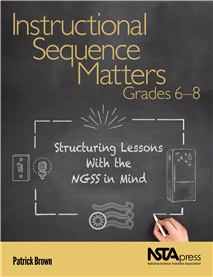Sequencing Matters: How to Promote Long-Lasting Understanding of Physical Science for Middle Schoolers
By Carole Hayward
Posted on 2018-11-07
 Beginner, as well as veteran, middle school science educators will find what they need to reimagine the teaching of physical science in Patrick Brown’s new NSTA Press book Instructional Sequence Matters, Grades 6-8: Structuring Lessons With the NGSS in Mind. The book guides its readers on how to make simple shifts in the way they arrange and combine activities to help their students construct knowledge using POE (Predict, Observe, and Explain) and 5E (Engage, Explore, Explain, Elaborate, and Evaluate), two popular approaches to structuring lessons.
Beginner, as well as veteran, middle school science educators will find what they need to reimagine the teaching of physical science in Patrick Brown’s new NSTA Press book Instructional Sequence Matters, Grades 6-8: Structuring Lessons With the NGSS in Mind. The book guides its readers on how to make simple shifts in the way they arrange and combine activities to help their students construct knowledge using POE (Predict, Observe, and Explain) and 5E (Engage, Explore, Explain, Elaborate, and Evaluate), two popular approaches to structuring lessons.
Science educators who are new to the profession can use the model lessons so that they have research-based strategies to improve student learning during their first years of teaching. Experienced teachers who find their lessons not influencing students as much as they intended can benefit from some simple reorganizing techniques that Brown lays out.
“Regardless of the level of experience, from novice to expert teacher, educators can read, implement, and dissect each model lesson to help reflect on how the sequence of science instruction promotes long-lasting understanding,” he says.
Brown, the executive director of STEM and career education for the Fort Zumwalt School District in St. Charles, Missouri, is known for his scholarship on instructional sequences to teach science. He describes his book as his “journey to translating the NGSS into practice,” one of the first challenges that most science educators face when implementing the new standards.
Drawing heavily on research about effective professional development that “highlights the important role of active learning in context and explicit reflection on practice,” Brown wrote this book to help educators understand why the order in which they structure their lessons is so critical; what planning considerations are needed to become an “explore-before-explain” teacher; and how to do three-dimensional learning and translate the NGSS into practice.
The book’s content stretches across 10 chapters and is linked to research experiences, including working with students, teacher preparation, and professional development. Each chapter builds on the one that precedes it.
Research shapes the content in Chapter 1, which takes readers through some emerging ideas about the intellectual abilities of students and the implications for instructional sequence.
If teachers want to produce more powerful learning experiences for their students, then practice must be grounded in current research on teaching and learning, Brown says. “What we know about students’ intellectual abilities and knowledge development is much different from what it was 20 or 30 years ago.”
The key components of the POE and 5E instructional models are discussed in Chapter 2. Brown includes activity boxes to help teachers reflect on their current hands-on practices and how they might be sequenced to support even higher levels of learning.
Chapter 3 describes three-dimensional learning, the integration of science and engineering practices, crosscutting concepts, and disciplinary core content—all of which are critical to promoting science literacy. Brown takes readers through each of the dimensions and includes activities to help teachers reflect on the lessons they are teaching and their connections to the NGSS.
Not sure where to start? In Chapter 4, Brown acknowledges that tackling your first 5E lesson “may seem daunting.” He offers guidance on how educators can create their own lessons that translate the NGSS, and he also presents activities that he’s used in his own practice as well as with preservice teachers and current teachers to design effective 5E units.
Model lessons for putting the explore-before-explain mindset into action—that use either the POE or the 5E instructional model—are included in Chapters 5-9 with illustrations that explain how both models easily support the NGSS. Science educators can teach lessons about heat and temperature using an investigative demonstration, investigate change using the invisible test tube demonstration, address students’ misconceptions of circuits, and more.
Brown begins the final chapter of his book by explaining that effective explore-before-explain teachers must integrate what they know about instructional activities, content, and learners “in a very intricate and organized matter.” He guides educators who are ready to take on this mission through five necessary steps. He also outlines what educators can do to support their colleagues and develop collaborative teams that are interested in developing POEs and 5Es into practice.
Effective teaching, Brown reminds readers, is about working smarter not harder. “Reflecting on and experiencing exploration before explanation instructional sequences opens up opportunities to construct a theoretical model for classroom lesson design so that all students gain higher levels of science literacy.”
Check out a sample chapter, “Teaching About Heat and Temperature Using an Investigative Demonstration.” This book is also available as an ebook.
Follow NSTA
Disclaimer: The views expressed in this blog post are those of the author(s) and do not necessarily reflect the official position of the National Science Teaching Association (NSTA).


